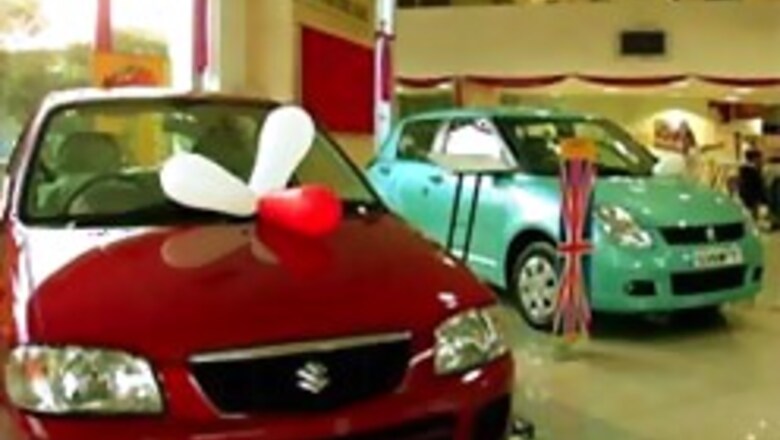
views
The Indian automotive industry is one of the fastest growing in the world. In fact, it is the world’s second largest two-wheeler manufacturer and can boast to be the world’s largest motorcycle manufacturer, with an industry turnover of $28 billion this year.
India manufacturers 13 lakh passenger vehicles and 76 lakh two-wheelers per year. The auto component market has a turnover of $10 billion and tires of $3 billion. But even with this rate of production, India’s auto sector is standing in the world is meager.
The sector is hoping to be able to increase volumes, to attract investments in the research and development space, and also to be able to upgrade to newer technology and innovations.
But in the last Budget, the Finance Minister had nothing to help the auto sector. So, this year, we are talking to people in the auto sector, to get a sense of what the Finance Minister can do.
Navin Munjal, CEO, Hero Exports and Head Electric Vehicle Divison says, “My expectations of the budget this year is to promote this new revolution through tax cuts and import duty subsidization and to promote this category.”
The eco-friendly e-bike requires no registration and no license to drive. This is Hero’s latest venture, starting in 1956. Known mainly for bicycles, Hero is riding the bigger dream. Navin Munjal is looking at better technology and reducing costs. In more than 300 dealerships across India, the next step is riding into the international market.
“This year, we are looking more and more to expand in the international markets, towards the North American, Canadian and European markets. That is an area, which we are again focusing on,” Munjal adds.
Business has, over the last one year, taken a bit of a slowdown, simply because the dollar is going the way it has. The dollar depreciation and rupee appreciation has affected exports drastically.
“We would look at this year for some kind of control. We are, at the end of the day, competing against China in the markets. If there is control at China’s end, there is no control and a free-fall at the dollar end, then there is a bit of a disparity in the buyers in the foreign nations. They just want a better product at the right price. So, they move towards China in that case.”
To counter the competition from China, as well as the growth in nascent electronic vehicles in India, is not an easy task. Navin is looking at making the e-bike, an easy and safe alternative for 16-17 year olds, as e-bikes can only do about 25kmph. They will soon target the three-wheeler market as well. But to be able to grow the market and improve R & D, Munjal says the industry needs government’s support.
“We would be looking at the government, to provide support in promoting this product. This is a new revolution that has happened across the country.”
It would give them much further range and a lot of independence, in order to commute, on a day-to-day basis. Besides that, there is also an issue of power. We would like to target this product to rural markets. But in lot of cases, the rural areas do not actually have electricity or have a very irregular supply of electricity. So, without electricity, how are you going to charge these products. So, that is the problem we face.
PAGE_BREAK
“We are trying to work on different options like solar, etc. But these are expensive and the propositions would take quite a while, before they can be commercially viable. So, we are right now looking at the government helping us expand in the network and providing some sort of tax benefits, so that we can bring these products to more and more markets,” Munjal opines.
Within the auto sector, there is a host of auto ancillary manufacturers, who are also looking for government intervention, to remain globally competitive and profitable.
Neeraj Kanwar, Joint MD, Apollo Tyres says, “Tax reforms should continue the way they are and come in line with the ASEAN countries.”
Apollo Tyres is one of the best known tyre brands to come out of India. It was the first Indian tyre company, to execute an overseas acquisition, when it took over Dunlop tyres in South Africa. It also became the first Indian tyre company to touch revenues of over $1 billion. The man heading this action is Neeraj Kanwar, Joint MD, Apollo Tyres. He joined the company in 1995 and is working towards touching the $2 billion mark in the revenue.
“We are very proud of having tires, which are meant for European roads and also for the Indian customer. Our growth plans are how to achieve and keep this USD 2 billion dollar target in the next three years. It is a very challenging target. It is going to be a combination of two things,” Kanwar says.
Organic growth is going to take place in the company in India and South Africa. The next is going to be an inorganic growth, for which we are looking at various markets and new opportunities in the tire industry.
He thinks the only way to become globally competitive is to become cost competitive. For this, government intervention is necessary.
“The government knows that there is an inverted duty structure that is currently in India. Natural rubber is imported at 20% duty, whereas a finished good product can be imported at 10%. That is what we are seeking, from the government, to correct this duty structure, “ Kanwar adds.
Wile the company is on the fast track, a possible FTA with China could be the biggest speed breaker.
Jagdish Khattar, Former MD, Maruti Suzuki says, “The auto sector is doing well. There are problems of rate of interest and other things. But they are not only confined to the auto sector. One hopes that it is a passing phase. So, if the rate of interest can be moderated, then there is nothing like it.”
“The tractor industry has been suffering as a whole, due to the non-availability of loans to the departments. So, the numbers have gone down until the last three years, when there was improvement year-after-year in sales. During the current year, there is a downward trend. If the government starts giving loan to the farmers, then this trend can be reversed even at this stage,” LD Mittal, Chairman, Sonalika Group says.
While Pawan Goenka, President, Automotive Sector M&M says, “The auto industry has been always asking for one thing, which is to make 16% excise duty uniform to all the vehicles. The Finance Minister had given this 16% to small cars two years ago and we have requested last year and this year, that it should be a uniform duty for all the vehicles. So, that is our primary request to the Finance Minister. We are looking at the various trade FTAs. On that, we need to know that we do not make the local industry non-competitive.”
“In the auto sector, normally all the vehicles are sold through finance only. So, if finance is taken care, then things will be smoother,” Deepak Kumar Raina, Senior Manager Dealear Development, Swaraj Mazda adds.
Jnaneshwar Sen, Senior GM Marketing, Honda Siel Cars says,” Budget is very friendly. The government is very proactive, and we would entirely go by the SIAM regulations on the Budget.”
“The norms of the entire Budget has to be tightened enormously. So, there is a consuming class, which is not able to acquire a two-wheeler. Probably, intervention over there would give some help to the industry,” Adrian Dass, Manager Corporate Communications, TVS says.


















Comments
0 comment